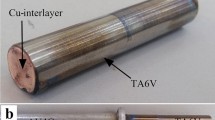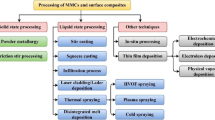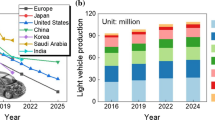Abstract
Applications of aluminum matrix composites are increasing in aerospace, automotive and biomedical fields because of their high strength, light weight and good wear resistant properties. From an intense literature review it is observed that various combinations of aluminum alloys have been developed through different manufacturing methodologies and their characteristics have been studied. It is identified that the study of a composite material consists of AA6061 alloy as a matrix material reinforced with SiC and B4C; a comparative experiment on sliding wear characteristics, hardness and wear resistant properties of nanocomposite with different aging time is a novel area yet to be undertaken. This paper presents a study of sliding wear characteristics in silicon carbide, boron carbide reinforcement prepared by using stir casting process. The hardness and wear resistance properties of nanocomposites with different aging time were measured in the work. When comparatively analyzed with AA6061, AA6061 reinforced with silicon carbide, AA6061 reinforced with boron carbide exhibited a steady and higher hardness than the other two metal composites. Also, we observed that when sliding wear characteristics are compared, the AMC reinforced with boron carbide exhibits an optimum wear rate. The optimal values of control parameters in wear rate and friction coefficient for boron carbide reinforced aluminum matrix composites are determined by response surface methodology. The control parameters considered are applied load, speed, weight % of reinforcement and distance. The effect of control parameters on the output variables was investigated by analysis of variance (ANOVA) and response plot. Interestingly, 27% increase in hardness value for B4C reinforced composite material at the aging time of 200 minutes was observed. Furthermore, wear rate for B4C reinforced composite material was four times reduced as compared to monolithic AA6061. These improvements may be attributed to the homogeneous particle size, particle distribution without agglomeration and optimized parameters.
Similar content being viewed by others
References
V. K. Lindroos and M. J. Talvitie, Recent advances in metal matrix composites, J of Materials Processing Technology, 53 (1–2) (1995) 273–284.
H. Kala et al., A review on mechanical and tribological behaviors of stir cast aluminum matrix composites, Procedia Materials Science, 6 (2014) 1951–1960.
S. Nallusamy, Analysis of welding properties in FSW aluminium 6351 alloy plates added with silicon carbide particles, International J of Engineering Research in Africa, 21 (2016) 110–117.
R. S. Mishra and Z. Y. Ma, Friction stir welding and processing, Materials Science and Engineering: R: Reports, 50 (1–2) (2005) 1–78.
H. S. Arora et al., Composite fabrication using friction stir processing—A review, The International J. of Advanced Manufacturing Technology, 61 (9–12) (2012) 1043–1055.
D. L. McDanels, Analysis of stress-strain, fracture, and ductility behavior of aluminum matrix composites containing discontinuous silicon carbide reinforcement, Metallurgical and Materials Transactions A 16 (6) (1985) 1105–1115.
M. Tan et al., Influence of SiC and Al2O3 particulate reinforcements and heat treatments on mechanical properties and damage evolution of Al-2618 metal matrix composites, J of Materials Science, 36 (8) (2001) 2045–2053.
L. M. Tham et al., Effect of limited matrix-reinforcement interfacial reaction on enhancing the mechanical properties of aluminium-silicon carbide composites, Acta Materialia, 49 (16) (2001) 3243–3253.
G. Cam and S. Mistikoglu, Recent developments in friction stir welding of Al-alloys, J of Materials Engineering and Performance, 23 (6) (2014) 1936–1953.
K. R. Brown et al., The increasing use of aluminum in automotive applications, JOM, 47 (7) (1995) 20–23.
S. M. Almotairy et al., Mechanical properties of aluminium metal matrix nanocomposites manufactured by assisted -Flake powder thixoforming process, Metals and Materials International (2019) 1–9.
P. Ravindran et al., Investigation of microstructure and mechanical properties of aluminum hybrid nanocomposites with the additions of solid lubricant, Materials & Design, 51 (2013) 448–456.
B. Saleh et al., Review on the influence of different reinforcements on the microstructure and wear behavior of functionally graded aluminum matrix composites by centrifugal casting, Metals and Materials International (2019) 1–28.
S. Nallusamy, A review on the effects of casting quality, microstructure and mechanical properties of cast Al-Si-0.3 Mg alloy, International J. of Performability Engineering, 12 (2) (2016) 143–154.
K. Ozturk et al., Preform - Based production of Al2O3 -Reinforced aluminum matrix composites by using various modification techniques, Metals and Materials International (2019) 1–10.
S. Mamnooni et al., In - situ synthesis of aluminum matrix composite from Al-NiO system by mechanical alloying, Metals and Materials International, 1–8 (2019).
S. Liu et al., Effect of pack rolling and heat treatment on microstructure and mechanical properties of B4CP/6061Al composite prepared by powder metallurgy, Metals and Materials International (2019) 1–8.
K. M. Shorowordi et al., Microstructure and interface characteristics of B4C, SiC and Al2O3 reinforced Al matrix composites: A comparative study, J. of Materials Processing Technology, 142 (3) (2003) 738–743.
E. Martin et al., Strain hardening behavior and temperature effect on Al-2124/SiCp, J. of Materials Processing Technology, 143 (2003) 1–4.
B. Ravi et al., Characterization of aluminium matrix composites (AA6061/B4C) fabricated by stir casting technique, Materials Today: Proceedings, 2 (4–5) (2015) 2984–2990.
S. Wang, T. Yue and M. A. Wahab, Multiscale analysis of the effect of debris on fretting wear process using a semi-concurrent method, Computers, Materials & Continua CMC, 62 (1) (2020) 17–35.
M. Djafri et al., Influence of thermal fatigue on the wear behaviour of brake discs sliding against organic and semi-metallic friction materials, Tribology Transactions, 61 (5) (2018) 861–868.
K. Pereira, T. Yue and M. A. Wahab, Multiscale analysis of the effect of roughness on fretting wear, Tribology International, 110 (2017) 222–231.
T. Yue and M. A. Wahab, A numerical study on the effect of debris layer on fretting wear, Materials, 9 (7) (2016) 597.
T. Yue and M. A. Wahab, Finite element analysis of stress singularity in partial slip and gross sliding regimes in fretting wear, Wear, 321 (2014) 53–63.
S. Ozden et al., Investigation of impact behavior of aluminum based SiC particle reinforced metal-matrix composites, Composites Part A: Applied Science and Manufacturing, 38 (2) (2007) 484–494.
V. C. Uvaraja and N. Natarajan, Tribological characterization of stir-cast hybrid composite Aluminum 6061 reinforced with SiC and B4C particulates, European J. of Scientific Research, 76 (4) (2012) 539–552.
S. Karabulut et al., Study on the mechanical and drilling properties of AA7039 composites reinforced with Al2O3/B4C/SiC particles, Composites Part B: Engineering, 93 (2016) 43–55.
R. Behera et al., Study on machinability of aluminum silicon carbide metal matrix composites, J. of Minerals & Materials Characterization & Engineering, 10 (10) (2011) 923–939.
D. J. Lloyd, The solidification microstructure of particulate reinforced aluminium/SiC composites, Composites Science and Technology, 35 (2) (1989) 159–179.
A. Devaraju et al., Influence of rotational speed and reinforcements on wear and mechanical properties of aluminum hybrid composites via friction stir processing, Materials & Design, 45 (2013) 576–585.
M. Saadatmand and J. A. Mohandesi, Modeling tensile strength of Al-SiC functionally graded composite produced using friction stir processing (FSP), Transactions of the Indian Institute of Metals, 68 (2) (2015) 319–325.
S. Soleymani et al., Microstructural and tribological properties of Al5083 based surface hybrid composite produced by friction stir processing, Wear, 278 (2012) 41–47.
S. A. Alidokht et al., Microstructure and tribological performance of an aluminum alloy-based hybrid composite produced by friction stir processing, Materials and Design, 32 (5) (2011) 2727–2733.
A. Devaraju et al., Influence of rotational speed and reinforcements on wear and mechanical properties of aluminum hybrid composites via friction stir processing, Materials and Design, 45 (2013) 576–585.
M. Moazami-Goudarzi and F. Akhlaghi, Wear behavior of Al 5252 alloy reinforced with micrometric and nanometric SiC particles, Tribology International, 102 (2016) 28–37.
F. Khodabakhshi et al., Microstructure and texture development during friction stir processing of Al-Mg alloy sheets with TIO2 nanoparticles, Materials Science and Engineering: A, 605 (2014) 108–118.
R. Hashemi and G. Hussain, Wear performance of Al/TiN dispersion strengthened surface composite produced through friction stir process: A comparison of tool geometries and number of passes, Wear, 324 (2015) 45–54.
K. Rajkumar et al., Microwave heat treatment on aluminum 6061 alloy-boron carbide composites, Procedia Engineering, 86 (2014) 34–41.
F. Toptan et al., Processing and microstructural characterisation of AA 1070 and AA 6063 matrix B4C reinforced composites, Materials and Design, 31 (S1) (2010) S87–S91.
N. Yuvaraj and S. Aravindan, Fabrication of Al5083/B4C surface composite by friction stir processing and its tribological characterization, J. of Materials Research and Technology, 4 (4) (2015) 398–410.
D. Patidar and R. S. Rana, Effect of B4C particle reinforcement on the various properties of aluminum matrix composites: A survey paper, Materials Today: Proceedings, 4 (2) (2017) 2981–2988.
J. Hashim et al., Metal matrix composites: Production by the stir casting method, J. of Materials Processing Technology, 92 (1999) 1–7.
K. R. Padmavathi and R. Ramakrishnan, Tribological behavior of aluminum hybrid metal matrix composite, Procedia Engineering, 97 (2014) 660–667.
R. G. Bhandare and P. M. Sonawane, Preparation of aluminum matrix composite by using stir casting method, International J. of Engineering and Advanced Technology (IJEAT), 3 (3) (2013) 61–65.
S. Poria et al., Wear and friction behavior of Al-TiB2-nano-Gr hybrid composites fabricated through ultrasonic cavitation assisted stir casting, Materials Research Express, 5 (5) (2018) 056509.
S. Chung and B. H. Hwang, A microstructural study of the wear behavior of SiCp/Al composites, Tribology International, 27 (5) (1994) 307–314.
B. Venkataraman and G. Sundararajan, The sliding wear behavior of Al-SiC particulate composites-1 macrobehavior, Acta Materialia, 44 (2) (1996) 451–460.
A. Karthikeyan and S. Nallusamy, Experimental analysis on sliding wear behavior of aluminium-6063 with SiC particulate composites, International J. of Engineering Research in Africa, 31 (2017) 36–43.
B. S. Unlii, Investigation of tribological and mechanical properties Al2O3-SiC reinforced Al composites manufactured by casting or P/M method, Materials and Design, 29 (10) (2008) 2002–2008.
Y. C. Feng et al., The properties and microstructure of hybrid composites reinforced with WO3 particles and Al18B403 whiskers by squeeze casting, Materials and Design, 30 (9) (2009) 3632–3635.
F. Tang et al., Dry sliding friction and wear properties of B4C particulate-reinforced Al-5083 matrix composites, Wear, 264 (7–8) (2008) 555–561.
B. V. Ramnath et al., Evaluation of mechanical properties of aluminum alloy-alumina-boron carbide metal matrix composites, Materials and Design, 58 (2014) 332–338.
L. Liu et al., Friction and wear properties of short carbon fiber reinforced aluminum matrix composites, Wear, 266 (7–8) (2009) 733–738.
M. Yildirim et al., Investigation of microstructure and wear behaviors of al matrix composites reinforced by carbon nanotube, Fullerenes Nanotubes and Carbon Nanostructures, 24 (7) (2016) 467–473.
Y. Iwai et al., Sliding wear behavior of SiC whisker-reinforced aluminum composite, Wear, 181 (P2) (1995) 594–602.
C. M. Rejil et al., Microstructure and sliding wear behavior of AA6360/(TiC+ B4C) hybrid surface composite layer synthesized by friction stir processing on aluminum substrate, Materials Science and Engineering: A, 552 (2012) 336–344.
A. E. P. A. Baradeswaran and A. E. Perumal, Influence of B4C on the tribological and mechanical properties of Al 7075-B4C composites, Composites Part B: Engineering, 54 (2013) 146–152.
F. Toptan et al., Reciprocal dry sliding wear behavior of B4Cp reinforced aluminum alloy matrix composites, Wear, 290 (2012) 74–85.
K. M Shorowordi et al., Microstructure and interface characteristics of B4C, SiC and Al2O3 reinforced Al matrix composites: A comparative study, J. of Materials Processing Technology, 142 (3) (2003) 738–743.
V. Auradi et al., Preparation characterization and evaluation of mechanical properties of 6061Al-reinforced B4C particulate composites via two-stage melt stirring, Materials and Manufacturing Processes, 29 (2) (2014) 194–200.
L. Poovazhagan et al., Processing and performance characteristics of aluminum-nano boron carbide metal matrix nanocomposites, Materials and Manufacturing Processes, 31 (10) (2016) 1275–1285.
H. Chen et al., The design, microstructure and tensile properties of B4C particulate reinforced 6061 Al neutron absorber composites, J. of Alloys and Compounds, 632 (2015) 23–29.
H. Chen et al., Microstructure evolution and mechanical properties of B4C/6061Al neutron absorber composite sheets fabricated by powder metallurgy, J. of Alloys and Compounds, 730 (2018) 342–351.
Y. Zhou et al., Distribution of the microalloying element Cu in B4C-reinforced 6061Al composites, J. of Alloys and Compounds, 728 (2017) 112–117.
Y. Z. Li et al., Interfacial reaction mechanism between matrix and reinforcement in B4C/6061Al composites, Materials Chemistry and Physics, 154 (2015) 107–117.
Y. N. Zan et al., Enhancing high-temperature strength of B4C- 6061 Al neutron absorber material by in-situ Mg(Al)B2, J. of Nuclear Materials, 526 (2019).
Acknowledgments
This paper was supported by the Deanship of Scientific Research at Prince Sattam bin Abdulaziz University, Alkharj, Saudi Arabia.
Author information
Authors and Affiliations
Corresponding author
Additional information
Recommended by Editor Chongdu Cho
Hussein Alrobei received both the M.S. in Mechanical Engineering in 2014 from University of South Florida, United States and the Ph.D. in 2018. Currently, he is an Assistant Professor of Mechanical Engineering, Prince Sattam Bin Abdu-laziz University, Al-Kharj, Saudi Arabia. His research interests include physical and photoelectrochemical properties of molybdenum disulfide alpha-hematite nanocomposite films.
Rights and permissions
About this article
Cite this article
Alrobei, H. Effect of different parameters and aging time on wear resistance and hardness of SiC-B4C reinforced AA6061 alloy. J Mech Sci Technol 34, 2027–2034 (2020). https://doi.org/10.1007/s12206-020-0424-9
Received:
Revised:
Accepted:
Published:
Issue Date:
DOI: https://doi.org/10.1007/s12206-020-0424-9




